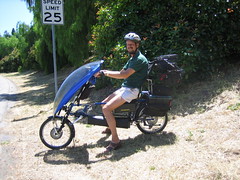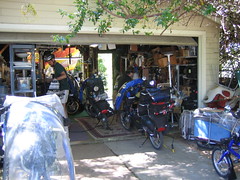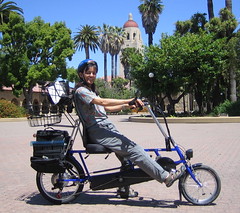Electric Bike Test Drive
My Sparrow languishes in Ed's garage waiting on parts that maybe are no longer being made, but we can't reach the company that makes the controllers because they are in some sort of transition. This is the problem with driving a car for which there is no company to call for support. If no part can be found, I'm hoping we can manufacture the needed part like the Cubans do for their classic 50's cars.
Owning a Sparrow definitely means having back-up wheels. One of the alternative vehicles I looked at was Mike Skeeter's recumbent bicycle with ad-on motor. Mike has been working on this project for ten years in his garage in Palo Alto. He himself uses the various prototype bikes for almost all his transportation needs. When I met him, he and his girlfriend were both riding on the bike. She was sitting in his lap. They had just spent the day riding to the coast, which means a long climb over the Santa Cruz Mountains.
Mike told me that his transportation concept was based on caloric intake vs. weight of vehicle to be moved. Basically he meant that we should really be measuring our transportation needs in terms of how much fuel it takes to transport ourselves in our vehicles rather than how much horse power we can access while moving. Do we want to be a bird or a dinosaur?
What I really wanted to know was what it was like to ride one of his bikes, so I dropped by his garage for a test drive. He outfitted me with a bike with one motor. His ride had two, but was heavier (100lb). I had no problem getting the hang of it and we headed for the nearest hill. The bike made it up Page Mill at a moderate 15 mph. After a half hour or so of travel, the motor quit on me. This is the problem with his one-motor bikes, he told me. They overheat and quit.
So we biked back (I pedaled) to the garage and I got on a bike with two motors. The idea was to switch between motors so they don't overheat. This was fine, but the heavier bike made it harder to maneuver when it was stationary. This raised the issue of safety. Hanging out on the road, especially the expressways we were traveling on in the bike lane, made me nervous. More so than when I rode a motorcycle (back in my bad ass, black leather days). At least on a motorcycle you can keep up with traffic and ride in the car lanes.
While I loved the concept of a recumbent bike with electric power, I felt too vulnerable on the road, more so than on a regular bicycle. Mike explained to me that recumbent bicycles were outlawed from competitive bicycle races precisely because they gave the rider so much more power. It was considered an unfair advantage! It was also argued that if recumbent bicycles were allowed in competitions the race would be more about the technology of the vehicle than the prowess of the rider. Maybe so. But on the street, a regular bicycle definitely has an advantage over the recumbent in that you can look at motorists from on high and this, I felt, was a psychological advantage. I much preferred to stare down at drivers to make sure they were going to give me the right of way.
The other issue about riding a motorized bicycle was that it was fine to be under the power of the motor, but when I had to pedal, I felt let down. Then when I was pedaling I wanted to keep pedaling for the exercise. I could probably get used to this, but it made me realize that having both was mostly cool in theory (because you're never out of power) and not as much fun in practice. Plus having both pedals and a motor made these vehicles more expensive. Mike wanted $5,000 for one of his. Another maker, Giant bicycles, also makes a semi-recumbent with a lithium battery for $2,200 and it was a finished vehicle. Mike's strapped together contraptions were not and I did not have the heart to point that out.
In the end I ordered an eGo Cycle for just over $1,000. This would give me the mobility of a motorized bicycle which could take hills and still be light enough to take on the BART and maybe even on the train. I would still have to live within its limited range of under 20 miles, but I wouldn't want to ride what was basically a moped for much further than that.
Owning a Sparrow definitely means having back-up wheels. One of the alternative vehicles I looked at was Mike Skeeter's recumbent bicycle with ad-on motor. Mike has been working on this project for ten years in his garage in Palo Alto. He himself uses the various prototype bikes for almost all his transportation needs. When I met him, he and his girlfriend were both riding on the bike. She was sitting in his lap. They had just spent the day riding to the coast, which means a long climb over the Santa Cruz Mountains.
Mike told me that his transportation concept was based on caloric intake vs. weight of vehicle to be moved. Basically he meant that we should really be measuring our transportation needs in terms of how much fuel it takes to transport ourselves in our vehicles rather than how much horse power we can access while moving. Do we want to be a bird or a dinosaur?
What I really wanted to know was what it was like to ride one of his bikes, so I dropped by his garage for a test drive. He outfitted me with a bike with one motor. His ride had two, but was heavier (100lb). I had no problem getting the hang of it and we headed for the nearest hill. The bike made it up Page Mill at a moderate 15 mph. After a half hour or so of travel, the motor quit on me. This is the problem with his one-motor bikes, he told me. They overheat and quit.
So we biked back (I pedaled) to the garage and I got on a bike with two motors. The idea was to switch between motors so they don't overheat. This was fine, but the heavier bike made it harder to maneuver when it was stationary. This raised the issue of safety. Hanging out on the road, especially the expressways we were traveling on in the bike lane, made me nervous. More so than when I rode a motorcycle (back in my bad ass, black leather days). At least on a motorcycle you can keep up with traffic and ride in the car lanes.
While I loved the concept of a recumbent bike with electric power, I felt too vulnerable on the road, more so than on a regular bicycle. Mike explained to me that recumbent bicycles were outlawed from competitive bicycle races precisely because they gave the rider so much more power. It was considered an unfair advantage! It was also argued that if recumbent bicycles were allowed in competitions the race would be more about the technology of the vehicle than the prowess of the rider. Maybe so. But on the street, a regular bicycle definitely has an advantage over the recumbent in that you can look at motorists from on high and this, I felt, was a psychological advantage. I much preferred to stare down at drivers to make sure they were going to give me the right of way.
The other issue about riding a motorized bicycle was that it was fine to be under the power of the motor, but when I had to pedal, I felt let down. Then when I was pedaling I wanted to keep pedaling for the exercise. I could probably get used to this, but it made me realize that having both was mostly cool in theory (because you're never out of power) and not as much fun in practice. Plus having both pedals and a motor made these vehicles more expensive. Mike wanted $5,000 for one of his. Another maker, Giant bicycles, also makes a semi-recumbent with a lithium battery for $2,200 and it was a finished vehicle. Mike's strapped together contraptions were not and I did not have the heart to point that out.
In the end I ordered an eGo Cycle for just over $1,000. This would give me the mobility of a motorized bicycle which could take hills and still be light enough to take on the BART and maybe even on the train. I would still have to live within its limited range of under 20 miles, but I wouldn't want to ride what was basically a moped for much further than that.




